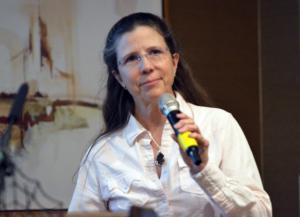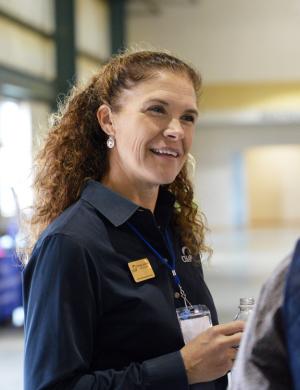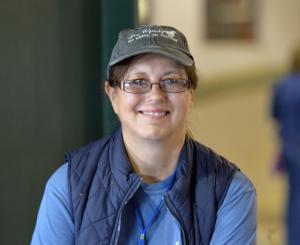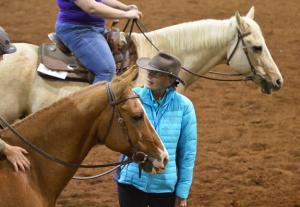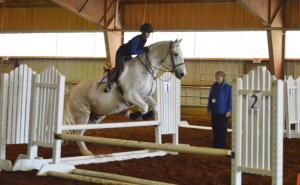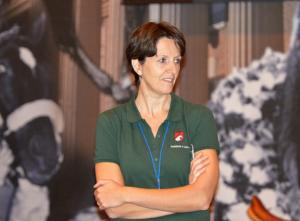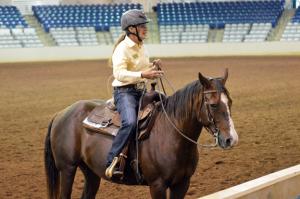Article & photos by Nancy Brannon, Ph.D.
The Certified Horsemanship Association (CHA) brought its International Conference to Middle Tennessee State University Horse Science Center and the Miller Coliseum in Murfreesboro, Tennessee, for three educational days, October 20-23, 2016. There were 150 attendees who came from all over the United States and Canada and as far away as Hawaii, Alaska, California, Oregon, Florida, Manitoba, Alberta, and Ontario.
The keynote speaker, Dr. Tom Lenz, DVM, spoke on Thursday afternoon about Animal Welfare issues and how the focus has changed. “In the past, welfare issues were discussed and resolved within the horse community, but this was the first national issue where non-horse owners and animal activists, as well as state and local officials, were involved in the debate and resolutions discussion. The result was a change on how we communicate and address equine welfare issues,” Lenz said.
Some of Friday morning’s presentations were: Mitzi Summers teaching new students the required basics and addressing their concerns; Ann Brzezicki teaching jumping exercises for different levels of riders and horses; and David Disher with Danielle Koren from Schleese Saddlery about the differences in anatomy and saddles for men and women.
Danielle Koren sat on two different saddles to demonstrate how traditional saddles are generally made for men, and how they put women in an “incorrect” position for several reasons. Her PowerPoint presentation showed diagrams of the anatomy and bone structure of men and women, emphasizing how the pelvic area is different. “A woman’s pelvis is a little more tilted and forward than a man’s,” she explained.
To be in proper position in the saddle, the rider should balance as if “standing” on the feet, with “good natural curves in the spine,” and not sitting in the chair seat. She showed where the centers of balance are for the horse and rider and that “both centers of gravity should align.”
She showed a very informative video of how the spine, hip, bones, and pelvis of the rider function in riding, generating a harmonious flow between human and horse.
“Today the majority of riders are female, in both English and western disciplines,” she said. “Women need a wider seat and a narrow twist in a saddle. The angle to the pommel should also be lower and the canter higher with extra padding the support the seat bones. The angle of the rider’s upper leg should match the flap of the saddle. And the stirrup bar should be extended so the stirrup sits back a little to accommodate the longer upper leg of the female rider. The saddle should put you in the position where you can be the most effective – and comfortable. The saddle should be designed to accommodate the female pelvic position.”
Friday’s special lunch presenter was the popular host of Horse Master, Julie Goodnight, emphasizing the importance the classics, i.e., Dressage, and demonstrating how to teach these basics to a varied group of horses and riders. She explained that she incorporates the “whys” into her teaching – why do we do that? She is encouraged by the new Western Dressage discipline, and believes it is important to bring these classical principles into all riding, and the principles behind dressage as a training philosophy.
As she explained the principles, she had the group ride in formation. “The horses will have to adjust their pace to keep in stride with the others.” She asked the riders to ride one behind the other in a line, at a distance that the rider can see the hind legs of the horse in front. She doesn’t use Dressage letters, but a series of cones to outline the arena, and teaches the “walls” and the “lines,” such as center line, quarter line. “The lines all have a usefulness and a purpose in the arena.”
“Forward motion is the basis of all training; moving forward freely,” she explained. “Straightness is the basis of forward motion. The wall helps with straightness and takes away 50% of direction options. Get off the wall to see how well straightness is working. Touch the horse’s neck with both hands to test straightness, and make it the horse’s job to stay there.”
After success at the walk, she asked the group to trot and then ride a downward transition to walk. “After the horse has been trotting, to transition to the walk just stop riding the trot. There shouldn’t be any pull on the reins,” she instructed.
She continued by having the group make direction changes, ride across the diagonal, ride the quarter line, and ride the center line. Across the diagonal, lengthen the trot, then compress the trot across the short side. “Always complete the short side of the arena before you come across the diagonal; lengthen on the diagonal; then shorten at the corners,” she said. “Bring the horse onto the bend before starting the turn. That makes it easier to collect.” Then she worked on 3-loop serpentines and circles, teaching how to ride them and where the inside/outside hands and legs should be positioned.
There was more instruction Friday afternoon and all day Saturday, with Saturday’s lunch special giving the opportunity to “Ride a Reiner.” Nashville area trainer and instructor Lisa Wysocky was on hand for several presentations, including The Green Barn.
Vendors provided additional information to attendees: Schleese and the Saddlefit 4 Life program; Equestrian Tai Chi, Equestrian Medical Safety Association (EMSA), Interscholastic Equestrian Association, Lisa Wysocky, ReVita Vet with Infrared therapy, Equine Office invoicing services, and the National Reining Horse Association (NHRA).
More information about this year’s conference is available at: cha-ahse.org and on facebook. A full schedule of events and speakers is available at: https://cha-ahse.netlou-secure.com/product_images/uploaded_files/Schedule.pdf Next year’s conference will be held at the Kentucky Horse Park and the Mariott Griffin Gate Hotel in Lexington, Kentucky, October 26-29, 2017.
The Certified Horsemanship Association (CHA) brought its International Conference to Middle Tennessee State University Horse Science Center and the Miller Coliseum in Murfreesboro, Tennessee, for three educational days, October 20-23, 2016. There were 150 attendees who came from all over the United States and Canada and as far away as Hawaii, Alaska, California, Oregon, Florida, Manitoba, Alberta, and Ontario.
The keynote speaker, Dr. Tom Lenz, DVM, spoke on Thursday afternoon about Animal Welfare issues and how the focus has changed. “In the past, welfare issues were discussed and resolved within the horse community, but this was the first national issue where non-horse owners and animal activists, as well as state and local officials, were involved in the debate and resolutions discussion. The result was a change on how we communicate and address equine welfare issues,” Lenz said.
Some of Friday morning’s presentations were: Mitzi Summers teaching new students the required basics and addressing their concerns; Ann Brzezicki teaching jumping exercises for different levels of riders and horses; and David Disher with Danielle Koren from Schleese Saddlery about the differences in anatomy and saddles for men and women.
Danielle Koren sat on two different saddles to demonstrate how traditional saddles are generally made for men, and how they put women in an “incorrect” position for several reasons. Her PowerPoint presentation showed diagrams of the anatomy and bone structure of men and women, emphasizing how the pelvic area is different. “A woman’s pelvis is a little more tilted and forward than a man’s,” she explained.
To be in proper position in the saddle, the rider should balance as if “standing” on the feet, with “good natural curves in the spine,” and not sitting in the chair seat. She showed where the centers of balance are for the horse and rider and that “both centers of gravity should align.”
She showed a very informative video of how the spine, hip, bones, and pelvis of the rider function in riding, generating a harmonious flow between human and horse.
“Today the majority of riders are female, in both English and western disciplines,” she said. “Women need a wider seat and a narrow twist in a saddle. The angle to the pommel should also be lower and the canter higher with extra padding the support the seat bones. The angle of the rider’s upper leg should match the flap of the saddle. And the stirrup bar should be extended so the stirrup sits back a little to accommodate the longer upper leg of the female rider. The saddle should put you in the position where you can be the most effective – and comfortable. The saddle should be designed to accommodate the female pelvic position.”
Friday’s special lunch presenter was the popular host of Horse Master, Julie Goodnight, emphasizing the importance the classics, i.e., Dressage, and demonstrating how to teach these basics to a varied group of horses and riders. She explained that she incorporates the “whys” into her teaching – why do we do that? She is encouraged by the new Western Dressage discipline, and believes it is important to bring these classical principles into all riding, and the principles behind dressage as a training philosophy.
As she explained the principles, she had the group ride in formation. “The horses will have to adjust their pace to keep in stride with the others.” She asked the riders to ride one behind the other in a line, at a distance that the rider can see the hind legs of the horse in front. She doesn’t use Dressage letters, but a series of cones to outline the arena, and teaches the “walls” and the “lines,” such as center line, quarter line. “The lines all have a usefulness and a purpose in the arena.”
“Forward motion is the basis of all training; moving forward freely,” she explained. “Straightness is the basis of forward motion. The wall helps with straightness and takes away 50% of direction options. Get off the wall to see how well straightness is working. Touch the horse’s neck with both hands to test straightness, and make it the horse’s job to stay there.”
After success at the walk, she asked the group to trot and then ride a downward transition to walk. “After the horse has been trotting, to transition to the walk just stop riding the trot. There shouldn’t be any pull on the reins,” she instructed.
She continued by having the group make direction changes, ride across the diagonal, ride the quarter line, and ride the center line. Across the diagonal, lengthen the trot, then compress the trot across the short side. “Always complete the short side of the arena before you come across the diagonal; lengthen on the diagonal; then shorten at the corners,” she said. “Bring the horse onto the bend before starting the turn. That makes it easier to collect.” Then she worked on 3-loop serpentines and circles, teaching how to ride them and where the inside/outside hands and legs should be positioned.
There was more instruction Friday afternoon and all day Saturday, with Saturday’s lunch special giving the opportunity to “Ride a Reiner.” Nashville area trainer and instructor Lisa Wysocky was on hand for several presentations, including The Green Barn.
Vendors provided additional information to attendees: Schleese and the Saddlefit 4 Life program; Equestrian Tai Chi, Equestrian Medical Safety Association (EMSA), Interscholastic Equestrian Association, Lisa Wysocky, ReVita Vet with Infrared therapy, Equine Office invoicing services, and the National Reining Horse Association (NHRA).
More information about this year’s conference is available at: cha-ahse.org and on facebook. A full schedule of events and speakers is available at: https://cha-ahse.netlou-secure.com/product_images/uploaded_files/Schedule.pdf Next year’s conference will be held at the Kentucky Horse Park and the Mariott Griffin Gate Hotel in Lexington, Kentucky, October 26-29, 2017.
